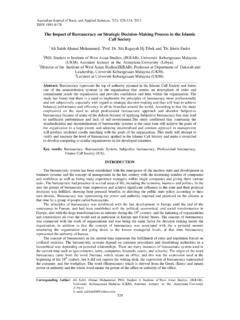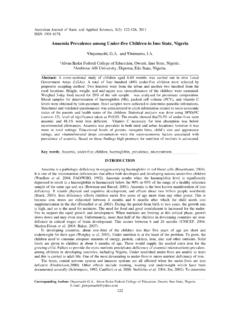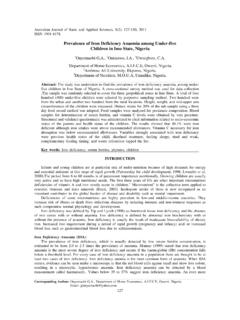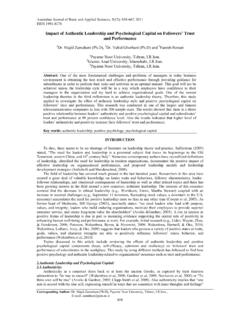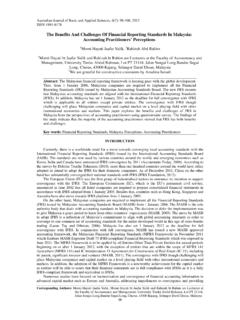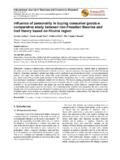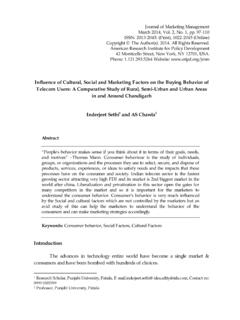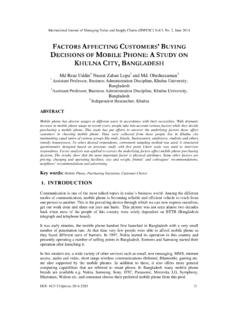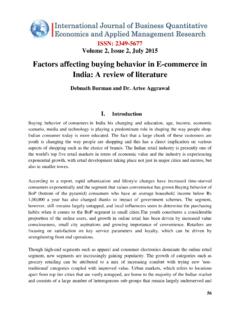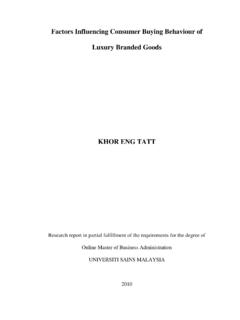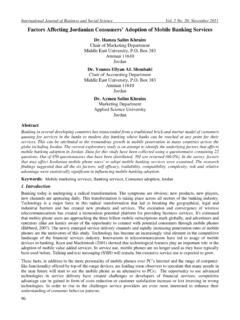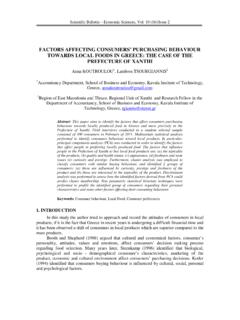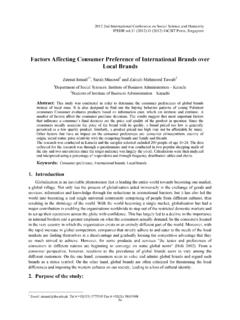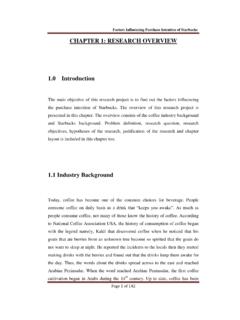Transcription of The Impulse Buying Behavior of Consumes For The FMCG ...
1 Australian Journal of Basic and Applied Sciences, 5(11): 1704-1710, 2011 ISSN 1991-8178 Corresponding Author: Dr. Tauseef Ahmad, Jai Narain Vays University Department of Accounting. 1704 The Impulse Buying Behavior of Consumes For The FMCG Products In Jodhpur Dr. Tauseef Ahmad Jai Narain Vays University Department of accounting Abstract: This paper is an attempt to find the variables/ factors that effects customer Impulse Buying Behavior in FMCG sector considering retail market in India. The impact of various Impulse Buying factors like sales and promotions, placement of products, window merchandising, effective price strategy etc on customer Impulse Buying Behavior has been analyzed.
2 A hypothetical model has created in this paper, which has been taken into consideration for our research work on Impulse Buying Behavior of the consumers. The study is based on the primary data collected from Shopping malls, Handlooms and marts from the area of JODHPUR with the help of structured questionnaire on likert scale. Data analysis has been done using SPSS software. The statistical analysis method employed in this study is Factor Analysis. After the through analysis of the available data it has been found out that since income of individual is increasing and more and more people are moving towards western culture in dressing sense, in eating etc so the purchasing power of the people has really gone up and thus the Impulse Buying of the commodities is on a great increment mainly due to pricing strategies of retail players and full of festivals throughout the year.
3 Key words: Impulse Buying , Retail industries in India, FMCG sector. INTRODUCTION Impulsive purchasing, generally defined as a consumer s unplanned purchase which is an important part of buyer Behavior . It accounts for as much as 62% of supermarket sales and 80% of all sales in certain product categories. Though impulsive purchasing has attracted attention in consumer research unfortunately, there is a dearth of research on group-level determinants. This research suggests that the presence of other persons in a purchasing situation is likely to have a normative influence on the decision to make a purchase. The nature of this influence, however, depends on both perceptions of the normative expectations of the individuals who exert the influence and the motivation to comply with these expectations.
4 Peers and family members, are the two primary sources of social influence, often have different normative expectations. Thus, it has been evaluated two factors that are likely to affect the motivation to conform to social norms: a) The inherent susceptibility to social influence and b) The structure of the group Group cohesiveness refers to the extent to which a group is attractive to its members. The theory proposed by Fishbein and Ajzen helps conceptualize these effects. This theory assumes that Behavior is a multiplicative function of expectations for what others consider socially desirable and the motivation to comply with these expectations.
5 Literature Review: Marketing and consumer researchers over the period of forty years have tried to grasp the concept of Impulse Buying and defined this terminology in their own perspectives, for which some research findings are discussed here. In a research conducted by Cobb and Hoyer (1986), Impulse Buying was defined as an unplanned purchase and this definition can also be found in the research of Kollat and Willett (1967). In another research by Rook (1987) reported that Impulse Buying usually takes place, when a consumer feels a forceful motivation that turns into a desire to purchase a commodity instantly. Beatty and Ferrell (1998) defined Impulse Buying as instantaneous purchase having no previous aim or objective to purchase the commodity.
6 Stern (1962) found that products bought on Impulse are usually cheap. Shopping lifestyle is defined as the Behavior exhibited by purchaser with regard to the series of personal responses and opinions about purchase of the products as reported by Cobb and Hoyer (1986). They find that shopping life style and Impulse Buying Behavior are closely related but only in the case of Impulse buyers. The study also states that Impulse purchasers fell in the middle as of the measurement tools used by the researchers, indicated that purchasers will not pick the first brand they spotted in the shopping mall. In researches conducted by (Cha 2001; Han et al.)
7 , 1991; Ko 1993) it is reported that Impulse Buying Behavior regarding fashion products are associated with patterns like chaste, repeated emotions as well as Aust. J. Basic & Appl. Sci., 5(11): 1704-1710, 2011 1705 fashion-oriented Impulse Buying behaviors. These facts were also quoted by Park et al., (2006). The definition of fashion involvement basically relates to apparel associated with fashionable outfits. The findings of Han et al., (1991) quoted in response to fashion involvement of consumers, that it might enhance fashion-oriented Impulse Buying behaviors among those who habitually wear fashion outfits. Fairhurst et al., (1989) and Seo et al.
8 , (2001) found a direct association among fashion involvement and apparels purchase. Positive emotions are defined as affects and moods, which determine intensity of consumer decision-making reported by Watson and Tellegen (1985). Park (2006) found a positive relationship of positive emotions, fashion involvement and fashion-oriented Impulse Buying with the overall Impulse Buying Behavior of the consumers. Ko (1993) reported that An Empirical Study of Consumer Impulse Buying Behavior in Local Markets 525 positive emotions may result into fashion related Impulse purchase. The researches of Beatty and (Ferrell 1998; Husman 2000; Rook and Gardner 1993; Youn and Faber, 2000) found that emotions strongly influence Buying behaviors, which result into consumer Impulse Buying .
9 Babin and Babin (2001) found that in stores consumer s purchasing intentions and spending can largely be influenced by emotions. These emotions may be specific to certain things for example, the features of the items, customer self interest, consumer s gauge of evaluating items and the importance they give to their purchasing at a store. Piron (1993) found that the total of nine items, a combination of pre-decision and post-decision stages indicators, resulted into high significant differences and the values of correlations for unplanned purchases done by consumers resulted into higher value as compared to purchases done by consumers on Impulse .
10 Their study indicated that out of total questionnaires distributed which were 361, 53 were unplanned purchasers and 145 were Impulse buyers (total= 198). Objectives of The Study: The main objective of the study is to investigate impulsive Buying Behavior amongst people living at Jodhpur. It will help: 1-To discover whether personality traits (lack of control, stress reaction, and absorption) trigger Impulse Buying behaviour. 2-To identify what Impulse products are in terms of expected price and product location. 3-To discover the differences between male and female consumers in Impulsive Buying behaviour. Research Methodology: The researcher contacted the respondents personally with well-prepared sequentially arranged questionnaire.
